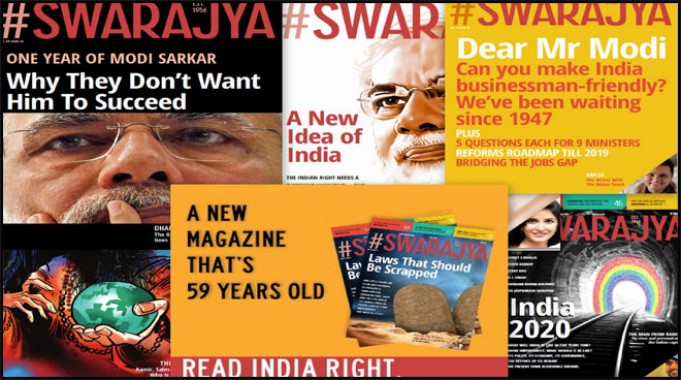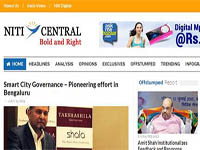Why this blatant cherry picking?
The article titled The Rise and Rise of online Hindutva by Saif Ahmad Khan left me both amused and aghast.
Amused at the paranoia about the right of centre view point (“It is noteworthy to mention that all the three websites . . . make use of the word “right”) and at the sweeping generalisation that anyone who is right of centre is a supporter of the RSS and the rabid Hindutva brigade.
Aghast that a student of journalism should have such complete disregard for basic facts and resort to the convenient deployment and concealment of information.
This piece is not going to dwell too much on my source of amusement – that an anti-right attitude is not restricted to journalism and journalists. There is a deliberate attempt to gloss over nuanced positions and paint everyone not in agreement with the left as rabid right-wing extremists, which needs to be countered, but The Hoot is not the forum for that.
Since The Hoot is a media watch website, I will only focus on facts related to Swarajya because Swarajya is a magazine and the author is a student of journalism.
Some disclosures are order: I write for and am associated with Swarajya in a consulting capacity. I do not know why the Swarajya management team did not counter this article earlier. They have not asked me to write this article nor have I shown it to them. I have been dubbed as a ‘sickularist’ and ‘Khangressi’, told to change my name to Surpanakha and told to go back to Sri Lanka for being even slightly critical of the BJP or conceding that the Congress may have been right on something. So I am also a victim of the so-called `online Hindu’ brigade.
How casual Khan has been with facts shows when he repeatedly refers to Swarajya Mag. There is no Swarajya Mag. The website and the monthly print magazine are both Swarajya; swarajyamag.com is merely the url. Just like thr url for Outlook magazine is outlookindia.com and that of Mint newspaper is livemint.com.
Now, to more substantive issues. I am confining myself to facts related to Swarajya because those are facts I know. I do not know all the facts about Niti Central or Centre Right (which has morphed into Swarajya, but I was never associated with it), but if Khan has erred on facts about Swarajya, it is quite possible that he would also have made mistakes relating to Niti Central and Centre Right.
Is that a far-fetched and unfair conclusion to come to? Perhaps, but that is precisely the kind of conclusion the author comes to regarding Swarajya.
Take this statement: “Though Swarajya Magazine claims to be “a fiercely independent, big tent of right liberal ideas” and not “politically partisan”, the presence of Dasgupta on the Board speaks volumes of the political affinity of the publication as Dasgupta is a known right-wing commentator who was recently awarded the Padma Bhushan by Narendra Modi’s government.”
So, Dasgupta is always defending the BJP on TV shows and he is also on the advisory board of Swarajya. Ergo, Swarajya is a BJP-RSS mouthpiece. What, then, are the Telegraph and the Times of India where Dasgupta writes a weekly column?
If the author had cared to spend some more time on the Swarajya website (he obviously has been to the site; he quotes from the editorial philosophy statement), he would have noticed that Dasgupta’s name figures fourth and last in the list of EAB members. The others, in the order of appearance, are: Jerry Rao, Surjit Bhalla and Bibek Debroy. If he had clicked on the `meet our editorial advisory board’ link, he would have seen that Manish Sabharwal of Teamlease also figures in the list. Once again Dasgupta’s is the fourth name.
So why did the author pick on only Dasgupta’s name and ignore the others? Was it because none of these people are apologists for even the BJP, let alone the RSS and the Hindu extremists? Rao is an unabashed admirer of the erstwhile Swatantra Party and its founders, C. Rajagopalachari `Rajaji’ and Minoo Masani.
Bhalla and Debroy are economists who are ardent free market advocates. Bhalla has often attacked the BJP for not controlling the sadhvis and yogis making incendiary comments and for bans on cow slaughter etc.; Debroy is a scholar of Sanskrit and the ancient scriptures but is nowhere close to being a RSS ideologue. Were their names not mentioned because this would not fit in with a particular image of Swarajya that is being put out – that it is a platform for the fringe Hindutva elements?
Look also at the other supposedly damning piece of evidence, the incontrovertible proof as it were, of Swarajya being a BJP-RSS mouthpiece that the author trots out: “Among the recent contributors to Swarajya is BJP spokesperson Sanjay Kaul.” Recent? Khan’s article appeared in July; Kaul’s article appeared in April. That is the only piece Kaul has written in Swarajya since the website was launched last August. Yet, this is a sign of Swarajya’s links with the BJP! By that yardstick, all those mainstream publications for which sundry BJP leaders write articles are all BJP mouthpieces.
The author says “In 2014, the duo of Govindarajan and Vishwanath went on to start Swarajya Mag. . . “. (If he had bothered to check, he would have got the right name – Vishwanathan.) Why did he not mention that Swarajya is not a new magazine but was started in the 1950s by Khasa Subba Rao and that C. Rajagopalachari `Rajaji’ was a mentor? That the founding team of Swarajya bought the rights to the title? It’s all there on the website.
Once again, was it because this will not fit with the image of Swarajya that is being sought to be portrayed? There is a large list of references given at the end of the article, but why is there no link to or mention of an interview given by Sandipan Deb, editorial director, to the Hindu where he sets out what Swarajya is all about? Was it because the interview makes it clear that Swarajya will provide a voice for the liberal right and not religious extremists?
“Crowdsourcing is a significant feature of the Hindutva media as websites like Swarajya invite contributions from its readers,” the author says. A host of new websites have come up – do they not crowdsource articles? An article by one of the co-founders of Swarajya, T. R. Vivek (who had left the venture last year) is quoted to show that most articles received are from extreme right-wingers ranting against Nehru and his policies. But the author gives no evidence to show that all those pieces get published. Vivek parted ways in November – within four months of the website going live and seven months before Khan wrote his article.
Khan bemoans the fact that Swarajya carried articles titled `how baniyas do business’ and `co-opting the railways to build India’s smart cities’. What do either of these have to do with online Hindutva, pray? The first is actually an extract from a book, Rokda: How Baniyas Do which profiles five businesses and has got favourable reviews, including in Business Today.
Khan names some provocative articles in Swarajya, which toe the line of the extreme Hindutva elements. But why did he not get hold of articles that contradict the RSS line on homosexuality not being part of Indian culture and differ with a RSS leader’s statement on the national anthem? Why did he not mention Jerry Rao’s pieces taking on the government on its management of the economy? Why is there no mention of articles that hit out at the government continuing to cling to ownership of public sector companies? Why does he play up only some Swarajya articles and ignore the others?
Would looking at the others have been too mammoth a task? Yes, it would. After all, Khan’s article was not about Swarajya but online Hindutva websites. But does that mean that one only takes facts which suit one’s thesis? I don’t know what journalism schools teach these days but when I started out in journalism over 30 years ago, one thing was drilled into us – if the facts don’t support your theory, drop the story.
In the last paragraph of his article, Khan writes: “While the Hindutva media portals have the right to contribute to, and shape public opinion in the country, they do not have the liberty to spread misinformation and hatred as they often do.” Oh. But it’s alright to spread misinformation about a website that doesn’t share your ideology?








